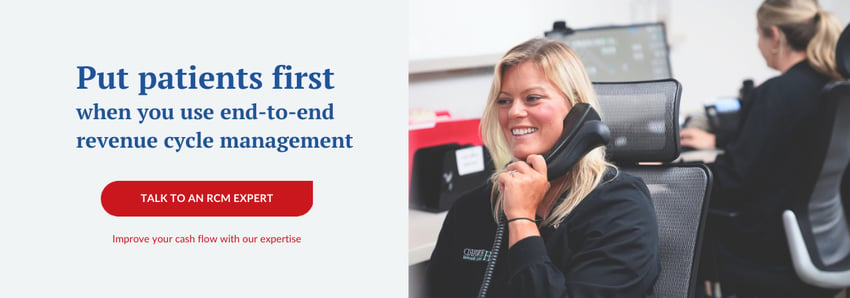11 common dental abbreviations your dental team needs to know


Have you ever used a term or dental abbreviation and you weren’t 100% sure what it meant, but you were embarrassed to ask? Everyone says there’s no such thing as a stupid question, but it’s still easy to feel silly when you keep coming across an acronym and realize you don’t understand what it means.
Hey, we’ve all run into unfamiliar things at first, and we’re here to help smooth your way with dental billing! As a dental billing company, we’ve become familiar with the myriad of terms and abbreviations that come with the territory of being in the dental industry. Specifically, insurance and billing dental abbreviations can trip people up, no matter how long they’ve been working in a dental practice.
In this article, you will learn the definition of 11 common insurance billing terms that are typically abbreviated (which can make working with insurance even more confusing!). Knowing exactly what these abbreviations and acronyms stand for and what they mean will give you and your dental team more confidence in your roles. It also allows you to clearly communicate with one another and with patients, which is what your patients need from you as a dental professional.
1. CDT - Current dental terminology
Current dental terminology (CDT) Code is a set of codes with descriptive terms developed and updated annually by the American Dental Association.
The CDT Code is the official reference for terms that must be used in claims to third-party payers like insurance companies.
If you submit dental claims as either an in-network or out-of-network dental care provider, or your work falls under HIPAA, you have to use these codes. They may already be present in your dental practice software, but you still need to know how to choose and use them correctly.
Your dental team uses these codes to report the services your dentist has performed for patients. These codes are reviewed and updated annually as technology and methods of procedures continuously evolve. Knowing how to use and document these claims correctly is the key to getting paid in the most cost-effective way.
2. EFT - electronic funds transfer
EFTs enable your practice to collect insurance payments without checks through the transfer of money online. This means when your dental practice gets paid from insurance claims using EFTs, the insurance company’s payment is a direct deposit into your bank account versus a check in the mail.
The nice thing about EFTs is there usually aren’t any merchant fees or delays since it is electronically paid to the bank account for your dental practice.
.jpg?width=740&name=pexels-karolina-grabowska-4386442%20(1).jpg)
3. ICD-10-CM - International Classification of Diseases, Tenth Revision, Clinical Modification
Similar to CDT codes, ICD-10-CM are codes used to document and report procedures that are performed by dentists, yet medical in nature. The difference is that the CMS (Centers for Medicare and Medicaid Services) is responsible for updating the ICD-10-CM annually. So, in the case of a dental office, it is used when you are filing a medical insurance claim.
ICD-10-CM communicates to the dental and medical payer information about a patient’s dental or medical condition(s) requiring the treatment listed on the claim form. Medical payers require at least one diagnosis code on the medical claim form, which is where this code list comes into play.
4. EOB - Explanation of Benefits
EOB is an insurance document provided to the patient and is also attached to the payment received by the practice. The EOB explains the benefits paid in detail by procedure. It’s a document telling the patient how their insurance benefits have been applied to the procedure, breaking down their cost.
Pro tip: The dental office AND patient both receive a copy of the EOB after a claim has been processed. If patients call and want to discuss an EOB, remember they have the same exact information you do.
For your practice’s benefit, it’s crucial to understand how to read EOBs to determine accurate payment from insurance or if you need to appeal a denied or downgraded claim. It’s important for practices to keep EOBs on hand for possible insurance audits, and questions from patients.
5. PPO - Preferred Provider Organization
For this type of insurance, patients typically have a choice of going to an office within your network or out-of-network. A PPO agreement may specify a copay or an out-of-pocket percentage for the patient to pay, depending on which plan the employer provides or the patient has purchased.
Joining a PPO network creates a larger number of providers for patients to choose from. Likewise, it gives dental and medical professionals access to a large subscriber base of patients looking for providers who will accept their insurance.
6. HMO - Health Maintenance Organization
HMOs are insurance plans which usually only cover care from your in-network providers. Patients can typically receive dental treatment for a set amount. You have a set copay amount that you always pay, and the HMO covers the remaining or a set portion of the cost for your procedure, similar to regular medical insurance.
HMO plans have lower monthly premiums and deductibles (compared to PPOs). Because HMOs offer less flexibility with your choice of dental providers, the overall costs for patients and those purchasing the HMO packages are lower.
Deep dive into HMO vs PPO: a simple guide for dentists in our Learning Center.
7. COB - Coordination of Benefits
Sometimes coverage from multiple insurance plans applies when treating a dental patient. COB determines the order in which the insurance benefits are considered for reimbursement. COB rules also determine the order in which the dental practice must file insurance claims.
So, when a patient has multiple insurance plans, (typically due to their spouse also having their own insurance) the patient will have primary and secondary insurance. There are a few conditions and rules to remember when handling COB. Training and experience are invaluable to collecting everything possible for your dental practice and reducing your patients' out-of-pocket costs
8. LEAT - Least expensive alternative treatment
This is a clause in some patients’ insurance plans that will tell your dentist they need to recommend a list of potential treatments for your needed service and the insurance will cover the least expensive option.
This of course doesn’t apply if there is only one option for treatment.
Insurance may determine the amount reimbursed based on LEAT. Your payment may reflect the least expensive treatment option, instead of the more expensive treatment actually performed (also known as a downgrade).
.jpg?width=696&name=DSC05659%20(1).jpg)
A common treatment where LEAT applies is for fillings. The patient can have a composite (white color) filling, OR the lower fee of the downgraded amalgam (silver color) filling. The white color is preferable because it’s the color of the tooth, but if it is a posterior (back) tooth, and the composite (white color filling) was performed, the insurance would downgrade the procedure and pay on the lower fee of the amalgam. This means insurance pays less and the patient comes out-of-pocket more.
Therefore, it’s up to patients what they choose to have in these cases. The amalgam does just as good of a job, if not a better job, than the composite, BUT the patient comes out-of-pocket more. It’s important for offices to explain these insurance nuances to their patients
9. OOP - Out-of-Pocket
The difference between what the patient’s procedure costs and the amount their insurance benefits will cover is the out-of-pocket cost. It’s crucial to get this number right in order to communicate an accurate cost to your patient, or else they can be understandably upset about getting an unexpected bill from you.
Calculating OOP isn’t always easy. When you are calculating this cost, it’s important to consider deductibles and downgrades, because this makes a straightforward equation a little bit challenging. Your dental software will do this calculation for you, but it’s still important to understand how to do it yourself so that you don’t have to rely on the technology.
10. DSO - Dental service organization
A DSO buys a dental practice and then supports the non-clinical operations behind the scenes. This means the DSO is more than likely handling the billing at the dental practice, along with marketing and anything administrative.
Similar to outsourced dental billing companies, DSOs sometimes also have centralized billing locations or billing teams that handle the revenue cycle for multiple dental offices remotely, rather than having each office handle its own billing in-house.
11. FFS - Fee for service
FFS is a revenue model for a dental practice that collects the entire cost of the procedure from a patient, then that patient is reimbursed by their insurance with a check in the mail a few weeks later based on the insurance claim.
A fee-for-service dental practice model means the provider is not participating, or credentialed, with any insurance companies. Because the provider is not in a contract with any dental insurance, or PPO (Preferred Provider Organization), the fees being charged to the patient would be the standard office fees.
An FFS practice may still file insurance claims and be reimbursed by the insurance company for covered services when the patient agrees to pay a predetermined amount upfront.
The more you know about dental billing terms, the more value you bring to your practice
Dealing with dental insurance billing terms can be a little daunting. However, your knowledge of terms is valuable to the success of your practice, because it can help you move through your billing process more easily, without being tripped up on what exactly something means or how it applies.
We at Dental ClaimSupport want your dental practice to be as successful as possible. That’s why we’re an educational resource to help you and our own expert billers stay up-to-date on dental insurance terms. We’re here to help you collect fully on insurance claims with the least possible stress.
Keep diving into your dental billing terminology knowledge by reading our Learning Center article, “Dental claim terminology: back to the basics” to avoid any future confusion that could slow or even halt your billing process, preventing your practice from collecting more.

Related Posts
Dental revenue resources from Dental Claim Support
